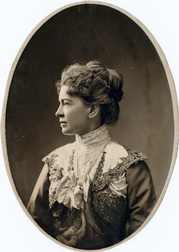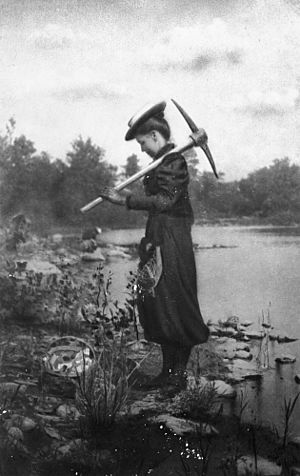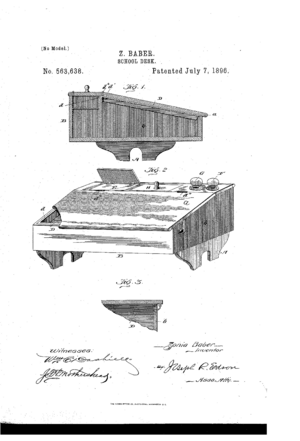Zonia Baber facts for kids
Quick facts for kids
Zonia Baber
|
|
|---|---|

Portrait of Zonia Baber
|
|
| Born |
Mary Arizona Baber
August 24, 1862 Kansas Township, Edgar County, Illinois, U.S.
|
| Died | January 10, 1956 (aged 93) East Lansing, Michigan, U.S.
|
| Burial place | Evergreen Cemetery, Lansing, Michigan |
| Education | University of Chicago (BS) |
| Occupation | Geologist, Teacher, Innovator, Principal, Geographer, Activist |
| Title | Founder of the Chicago Geographical Society |
Mary Arizona "Zonia" Baber (born August 24, 1862 – died January 10, 1956) was an American geographer and geologist. A geographer studies the Earth's surface, including its landforms, climates, and how people live on it. A geologist studies the Earth's rocks, minerals, and history.
Zonia Baber is famous for creating new ways to teach geography. She believed students should learn by doing, not just by memorizing facts. Her teaching methods focused on hands-on activities and exploring the world around them.
Contents
Zonia Baber's Education and Teaching Career
Zonia Baber grew up in Dudley, Illinois. Her hometown did not have schools past elementary level. So, she moved to Paris, Illinois, to attend high school. After high school, she went to a "Normal school" to become a teacher.
Early Teaching Roles
Baber started her career as a principal at a private school from 1886 to 1888. After that, she taught at Cook County Normal School. She became the head of the Geography Department there from 1890 to 1899.
She taught how geography, history, and natural sciences are all connected. Her courses covered geography, studies of continents, weather, and how math relates to geography. While teaching, Baber also studied geology. She even took the first geology class that allowed women. She earned her Bachelor of Science degree in 1904.
Teaching at the University of Chicago
From 1901 to 1921, Zonia Baber worked at the University of Chicago. She was an associate professor and led the geography and geology sections in the Department of Education. At the same time, she was also the principal of the University of Chicago Laboratory Schools.
Innovative Teaching Methods
Zonia Baber loved teaching through "field work." This meant taking students outside to explore and discover things for themselves. She wanted them to act and learn, not just memorize information. Many of her teaching ideas are still used in schools today.
Baber encouraged field trips and direct experiences. She also worked to make regular learning tools better. For example, she led a group that reviewed textbooks. They wanted to remove old or unfair ideas and replace them with concepts that promoted fairness and understanding.
In 1920, Baber suggested new names for parts of the Earth. She proposed calling the Tropic of Cancer "The Northern Tropic" and the Tropic of Capricorn "The Southern Tropic." Today, both sets of names are accepted in geography.
Geographic Society and Advocacy Work
In 1898, Zonia Baber helped start the Geographic Society of Chicago. She was the President and worked with the Society for 50 years. In 1948, she received an award for her lifetime of work.
Fighting for Fairness
Zonia Baber cared deeply about social issues. She was a feminist, meaning she supported equal rights for women. She also opposed imperialism, which is when one country controls another. She joined many groups to fight against sexism, racism, and unfairness.
She strongly supported women's right to vote in the United States. In 1926, she spoke for the women of Puerto Rico to help them get the right to vote.
Baber was also the leader of the Women's International League for Peace and Freedom (WILPF). She was a member of the executive committee for the National Association for the Advancement of Colored People's (NAACP) Chicago branch. She also led the Race Relations Committee of the Chicago Women's Club.
Zonia Baber traveled a lot for her work and her activism. She went to international meetings and events. For example, she traveled with a WILPF group to Haiti in 1926.
Innovative School Desk Design
In 1896, Zonia Baber designed a special school desk. It had features just for teaching geography and other sciences. Unlike a regular desk, hers had trays and compartments. These were meant to hold learning supplies. This meant students using her desk always had their tools ready.
Images for kids
See also
 In Spanish: Zonia Baber para niños
In Spanish: Zonia Baber para niños




